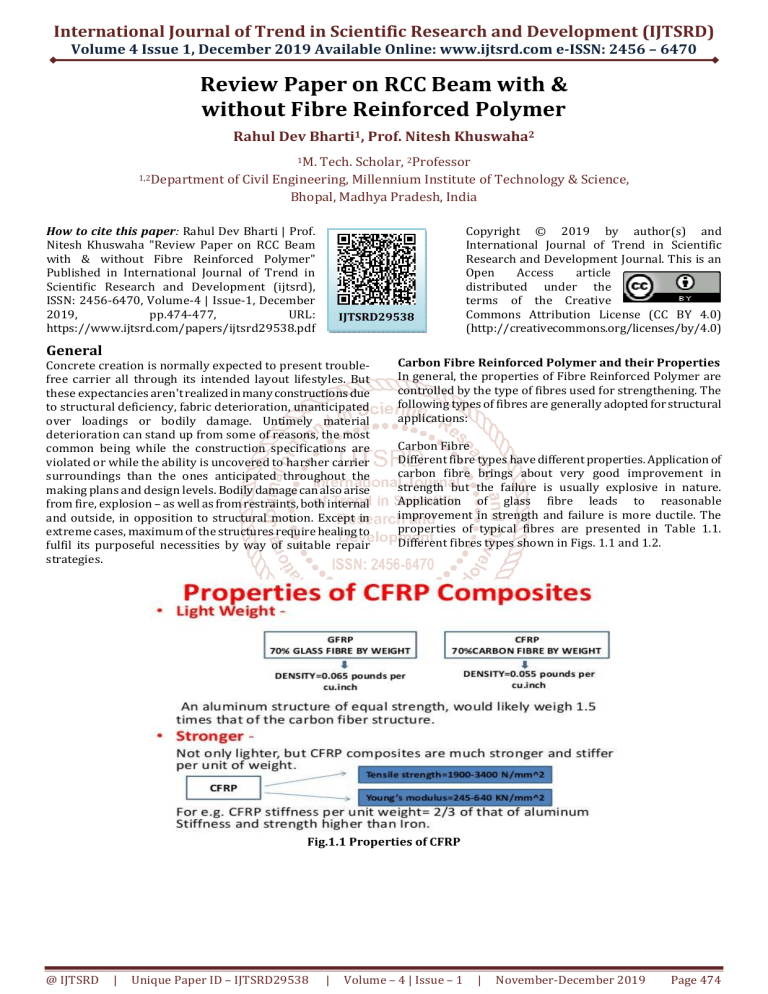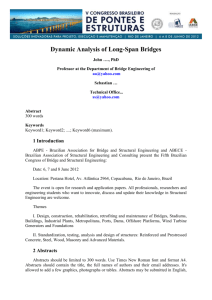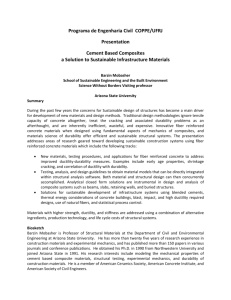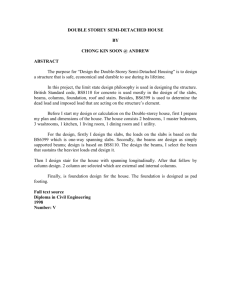
International Journal of Trend in Scientific Research and Development (IJTSRD) Volume 4 Issue 1, December 2019 Available Online: www.ijtsrd.com e-ISSN: 2456 – 6470 Review Paper on RCC Beam with & without Fibre Reinforced Polymer Rahul Dev Bharti1, Prof. Nitesh Khuswaha2 1M. Tech. Scholar, 2Professor 1,2Department of Civil Engineering, Millennium Institute of Technology & Science, Bhopal, Madhya Pradesh, India How to cite this paper: Rahul Dev Bharti | Prof. Nitesh Khuswaha "Review Paper on RCC Beam with & without Fibre Reinforced Polymer" Published in International Journal of Trend in Scientific Research and Development (ijtsrd), ISSN: 2456-6470, Volume-4 | Issue-1, December 2019, pp.474-477, URL: https://www.ijtsrd.com/papers/ijtsrd29538.pdf IJTSRD29538 Copyright © 2019 by author(s) and International Journal of Trend in Scientific Research and Development Journal. This is an Open Access article distributed under the terms of the Creative Commons Attribution License (CC BY 4.0) (http://creativecommons.org/licenses/by/4.0) General Concrete creation is normally expected to present troublefree carrier all through its intended layout lifestyles. But these expectancies aren't realized in many constructions due to structural deficiency, fabric deterioration, unanticipated over loadings or bodily damage. Untimely material deterioration can stand up from some of reasons, the most common being while the construction specifications are violated or while the ability is uncovered to harsher carrier surroundings than the ones anticipated throughout the making plans and design levels. Bodily damage can also arise from fire, explosion – as well as from restraints, both internal and outside, in opposition to structural motion. Except in extreme cases, maximum of the structures require healing to fulfil its purposeful necessities by way of suitable repair strategies. Carbon Fibre Reinforced Polymer and their Properties In general, the properties of Fibre Reinforced Polymer are controlled by the type of fibres used for strengthening. The following types of fibres are generally adopted for structural applications: Carbon Fibre Different fibre types have different properties. Application of carbon fibre brings about very good improvement in strength but the failure is usually explosive in nature. Application of glass fibre leads to reasonable improvement in strength and failure is more ductile. The properties of typical fibres are presented in Table 1.1. Different fibres types shown in Figs. 1.1 and 1.2. Fig.1.1 Properties of CFRP @ IJTSRD | Unique Paper ID – IJTSRD29538 | Volume – 4 | Issue – 1 | November-December 2019 Page 474 International Journal of Trend in Scientific Research and Development (IJTSRD) @ www.ijtsrd.com eISSN: 2456-6470 Fig.1.2 Manufacture of CFRP Literature Survey General Literature Review 1. Jasmin S.P. (2018). This work presents retrofitting of reinforced concrete beams which are weak in flexure using Basalt fiber reinforced polymer (BFRP) subjected to two point loading. The main aim of this study is to rehabilitate the structurally deficient beam and to make it serviceable in flexure. Experiment consists of six RCC beams. Of the six beams two beams were control beams. Remaining four beams were preloaded to 70% of the ultimate load of the control beam. The beams were then retrofitted by wrapping BFRP on the tension zone and flexural zone. Load–deflection behavior, energy absorption, failure modes and crack propagation patterns are studied extensively. Experimental results are validated with ANSYS software. Parametric study is done in ANSYS for full scaled beams. Various parameters considered are number of layers of wrapping and material of wrapping. Retrofitting with BFRP wraps make structure more efficient and restore stiffness and strength values greater than those of control beams. 2. Hayder Alaa Hasan, M. Neaz Sheikh, Muhammad N.S. Hadi (2017). The consequences of a trial examination on high quality cement (HSC) and steel fiber high quality cement (SFHSC) round segment examples fortified longitudinally and transversely with Glass FiberReinforced Polymer (GFRP) bars and helices, separately. The Influence of the kind of the fortification (steel and GFRP), the pitch of the transverse support, the expansion of the steel filaments and the stacking condition (concentric, capricious and four-point stacking) on the execution of the examples were examined. The examination demonstrated that the GFRP bar fortified HSC (GFRPHSC) example is as productive as the steel bar strengthened HSC (steel-HSC) example in supporting concentric pivotal burden. Notwithstanding, the most extreme burden supported by the GFRP-HSC examples under unusual hub load was 10– 12% lower than the greatest burden continued by the steel-HSC examples. GFRP bar strengthened SFHSC (GFRP-SFHSC) examples continued 3– 13% higher pivotal burden and 14– 27% more noteworthy malleability than GFRP-HSC examples under various stacking conditions. Besides, decreasing the contribution of the GFRP helices GFRPSFHSC examples brought about a critical improvement @ IJTSRD | Unique Paper ID – IJTSRD29538 | in the flexibility and the post-top hub load-hub disfigurement conduct of the examples. 3. M. Moradi, M. Reza Esfahani (2017). Utilizing steel fiber fortified cement (SFRC) causes huge improvement in the conduct of profound pillars with openings. This paper proposed a technique for planning SFRC profound shafts with opening, which was gotten from past examinations on the conduct demonstrating of SFRC bars under pressure and structure standards of swagger and tie strategy. To assess the proposed technique, four expansive scale examples were utilized, which included two SFRC and two fortified solid profound shafts with opening. Aftereffects of the test arrangement showed the appropriateness of the proposed technique. 4. M.A. Al-Osta, M.N. Isa, M.H. Baluch, M.K. Rahman (2017). The adequacy and effectiveness of two distinct methods for fortifying of strengthened cement (RC) bars utilizing ultra-superior fiber fortified cement (UHPFRC) was researched i.e.; (I) by sand impacting RC pillars surfaces and throwing UHPFRC in-situ around the bars inside a shape and (ii) by holding pre-assembled UHPFRC strips to the RC shafts utilizing epoxy cement. Shafts under every method were fortified in three diverse fortifying arrangements; (I) base side reinforcing (ii) two longitudinal sides reinforcing (iii) three sides fortifying. Bond quality tests were completed to find out the bond between typical cement and the UHPFRC, for both sand impacting and epoxy glue procedures. Test results for retrofitted bars under flexure viewing different conduct qualities, for example, break proliferation, solidness and disappointment load showed huge positive improvements coming about because of the two reinforcing strategies. Bars reinforced on three sides demonstrated the most astounding limit upgrade, while shafts fortified just at the base side demonstrated the least improvement. Be that as it may, there were a few concerns in regards to loss of malleability with expanded utilization of UHPFRC as a major aspect of the elastic retrofit. Limited component (FE) and diagnostic models were created to foresee the conduct of the shaft examples. The aftereffect of the models indicated great concurrence with test results, as they had the capacity to anticipate the conduct of the pillars with high precision. Volume – 4 | Issue – 1 | November-December 2019 Page 475 International Journal of Trend in Scientific Research and Development (IJTSRD) @ www.ijtsrd.com eISSN: 2456-6470 5. J. F. Dong, Q. Y. Wang, Z. W. Guan (2017 Solid waste comprises the significant extent of development squanders which relies on about half of the complete squanders created. The utilization of reused totals serves to advance the reusing of cement in the development business just as to suit the recreation need in quake zones. This paper introduces an examination of mechanical properties and microstructures of basalt fiber (BF) fortified reused total cement (RAC). The primary parameters considered in the investigation are the substitution proportion of reused coarse totals (RCA) and the substance of the basalt fiber. The examination work is centered around the impacts of the above parameters on the disappointment mode, compressive quality, rigidity, flexible modulus, Poisson's proportion and a definitive strain of the BF fortified RAC. The outcomes demonstrate that the mechanical properties of RAC can be improved by utilizing BF. The SEM perceptions of the solid uncover that the BF collected in pores and on the outside of the appended mortar can reinforce the RAC, yet additionally improve the microstructure of the interfacial change zone (ITZ), which further upgrades the quality and flexibility of the RAC. Along these lines, the basalt fiber strengthened RAC can be utilized in development to lessen the natural dangers from a lot of quakes squander from fallen structures. 6. Regine Ortlepp, Sebastian Ortlepp (2017). with regards to remodeling and fix work or when structures are to be adaptively reused, the arranging engineer is much of the time required to fortify the heap bearing structure. This is the situation, for instance, if live loads will increment because of changes being used or if the basic honesty of a structure must be reestablished after a flame or seismic tremor. Sections are especially indispensable segments and components of the static arrangement of numerous structures. Their principle errand is to withstand hub powers. This article depicts the aftereffects of test tests on the impact of fortifying 2 m long segments (with and without inward steel support) utilizing material strengthened cement (TRC). Two types of reinforcing were explored: Complete wrapping with TRC along the full tallness of the segments and halfway wrapping along 300 mm in the heap presentation ranges. Discoveries demonstrate the greatest increment of up to 85% in burden limit contrasted with nonstrengthened reference segments. The individual parts of the heap bearing properties were dissected and a basic computation demonstrate connected. OBJECTIVES To evaluate the effectiveness of the use of FRP laminates as external reinforcement to reinforced concrete frames Beam section subjected to stress and Deformation. CONCLUSION A load and stress response was measured when FRP reinforcement was provided and a response was observed that, relatively more reduction in stress is also considered in FRP sheet as compare to Without FRP concrete. @ IJTSRD | Unique Paper ID – IJTSRD29538 | REFERENCES [1] Al-Salloum, Y.A., Alsayed, S. H., Almusallam, T. H., and N. A. Siddiqui. (2007). "Seismic Rehabilitation of Shear Deficient Interior Beam-Column Joints Using FRP Sheets." Accepted for Presentation in the 7th Saudi Engineering Conference (SEC7), 26-28 November, Riyadh, Saudi Arabia. [2] Battula Sudheer Kumar and Rajalapati, “Tensile Properties of Long Jute Fiber Reinforced Polypropylene Composites” ,International Journal of Engineering Inventions,vol.3, pp.45-56, 2012. [3] Büyükkaragöz, A. (2010). “Finite Element Analysis of the Beam Strengthened with Prefabricated Reinforced Concrete Plate,” Scientific Research and Essays, V. 5. No. 6, pp. 533-544. [4] Hayder Alaa Hasan, M. Neaz Sheikh, Muhammad N.S. Hadi (2017). “Performance evaluation of high strength concrete and steel fibre high strength concrete columns reinforced with GFRP bars and helices,” Construction and Building Materials 134 (2017) 297– 310. [5] ILki, Alper., Bedirhangolu, Idris., and Kumbasa, Nadir., (2011). “Behaviour of FRP- Retrofitted Joints Built with Plain Bars and Low Strength Concrete.” Journal of Composite Construction, ASCE, vol.15, No 3, pp 312326. [6] J.F. Dong, Q.Y. Wang, Z.W. Guan (2017). “Material properties of basalt fibre reinforced concrete made with recycled earthquake waste,” Construction and Building Materials 130 (2017) 241–251. [7] J.Poornima and M.Sivaraj “Performance Enhance-ment of Concrete Structures using Natural Fibre Composites” European Journal of Scientific Research, vol.3, pp.22-30, 2012. [8] Joh, Osamu., Goto Yasuaki. (2000). “Beam Column Joint Behaviour after Beam Yielding in R/C Ductile Frames.” paper presented on 12 WCEE Conference, Auckland, New Zealand., 30January-04 February. [9] Li, Bing., and Qi, Qiang. (2011). “Seismic Behaviour of the Reinforced Concrete Interior Beam-Wide Column Joints Repaired using FRP.” Journals of Composites for Construction, ASCE, May-June, vol 15, No 3, , pp 327338. [10] M. Moradi, M. Reza Esfahani (2017). “Application of the strut-and-tie method for steel fiber reinforced concrete deep beams,” Construction and Building Materials 131 (2017) 423–437. [11] M.A. Al-Osta, M.N. Isa, M.H. Baluch, M.K. Rahman (2017). “Flexural behavior of reinforced concrete beams strengthened with ultra-high performance fiber reinforced concrete,” Construction and Building Materials 134 (2017) 279–296. [12] Mahmood, M. N. and Mahmood, A. Sh.(2011) “Torsional behaviour of prestressed concrete beam strengthened with CFRP sheets” 16th International Conference on Composite Structures, ICCS 16. [13] Mostofinejad, D. and Talaeitaba, S. B. (2006). “Finite Element Modeling of RC Connections Strengthened with FRP Laminations,” Iranian Journal of Science & Volume – 4 | Issue – 1 | November-December 2019 Page 476 International Journal of Trend in Scientific Research and Development (IJTSRD) @ www.ijtsrd.com eISSN: 2456-6470 Technology, V. 30, No. Bl, pp. 21-30. [14] Mukharjee, Abhijeet., and Joshi., Mangesh., (2005). “FRPC Reinforced Concrete Beam-Column Joints under Cyclic Excitation.” Journal of Composite Structure, 70 (02) pp 185-199. [15] Murshed, Arefin., and Ahmed, Ishtiaque., (2011). “Seismic Performance of Soft Storey Structures Retrofitted with FRP Wraps.” MSc Thesis Paper., Bangladesh University of Engineering and Technology. [16] Pampanin, S., Calvi, G M., and Moratti, M.. (2002). “Seismic Behaviour of R.C. Beam- Column Joints Designed for Gravity Loads.” paper presented on 12th European Conference on Earthquake Engineering., 913 September, London. [17] Pantelides, P Chris., Chandra, Clyde., and Dreaveley, Lawrence. (2000). “Rehabilitation of R/C Building Joints with FRP Composites.” paper presented on 12 WCEE Conference, Auckland, New Zealand., 30January04 February. [18] Poorna Prasad Rao.O.L, Rama Mohan Rao .P, “Retrofitting of RC beams using rubberised coir fiber sheets @ IJTSRD | Unique Paper ID – IJTSRD29538 | ” International journal of civil engineer-ing,vol.3.,pp.2028,2016 [19] Regine Ortlepp, Sebastian Ortlepp (2017). “Textile reinforced concrete for strengthening of RC columns: A contribution to resource conservation through the preservation of structures,” Construction and Building Materials 132 (2017) 150–160. [20] Rohit Vasudeva And Mandeep Kaur , “Retrofit-ting of RC beams using glass fiber reinforced pol-ymer sheets” Indian journal of science and technology , vol.9,pp.1222,2016. [21] Shiohara, Hitoshi., and Kusiara, Fumio. (2010). “An Overlooked Failure Mechanism of Reinforced Concrete Beam-Column Joints,” proceedings of the 9th U.S. National and 10th Canadian Conference on Earthquake Engineering, July 25-29, Toronto, Ontario, Canada. [22] Tara sen and H.N. Jagannatha Reddy, “A Numeri-cal Study of Strengthening of RCC beams using Natural Jute Fiber and its comparative study with CFRP and GFRP strengthening system” International journal of sustainable build environ-ment,vol.3,pp.12-22,2014. Volume – 4 | Issue – 1 | November-December 2019 Page 477




